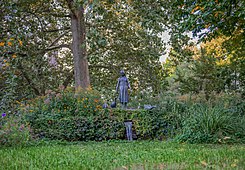Nikolsburger Platz
| Nikolsburger Platz | |
|---|---|
| Place in Berlin | |
 Gänselieselbrunnen on Nikolsburger Platz |
|
| Basic data | |
| place | Berlin |
| District | Wilmersdorf |
| Created | 1870 |
| Newly designed | 1960s |
| Confluent streets |
Landhausstrasse , Nikolsburger Strasse , Trautenaustrasse |
| use | |
| User groups | Pedestrians , cyclists , road traffic |
The Nikolsburger Place is located in the Berlin district of Wilmersdorf . The Landhausstrasse and Nikolsburger Strasse flow into it . The Trautenaustrasse crosses it.
history
It was built in 1870 by Johann Anton Wilhelm von Carstenn as a southwestern representative and jewelery square in the " Carstenn figure " designed by him , an urban ensemble to which the Fasanenplatz , Nürnberger Platz and Prager Platz belong. From 1876 it was called Magdeburger Platz , and in 1888 it was given its current name. The name recalls the preliminary peace in Nikolsburg on July 26, 1866, which ended the German war between Prussia and Austria . The former Nikolsburg is now called Mikulov ( Czech Republic ). Through the name it was always connected with its mirror-image counterpart , the Prager Platz (previously: Halberstädter Platz ): The peace of 1866 was called the "Peace Treaty of Prague and Nikolsburg" (chronological order not entirely consistent), and the two bishoprics Magdeburg and Halberstadt connected a centuries-long history of the Hohenzollern and Protestantism .
At the beginning of the 20th century, the square was given a green area with wooden benches and in 1910 a bronze fountain designed by Cuno von Uechtritz-Steinkirch , which depicts a goose with a goose. In the same year the Cäcilien-Lyceum of the architect Otto Herrnring was completed in neo-renaissance form on the edge of the square , which dominates the square to this day and houses the Cecilenschule.
In 1940 the fountain was melted down by the National Socialists for armament. During the 1960s, the Horticultural Office created raised beds in a checkerboard pattern on the square . Harald Haacke created a replica of the historic Gänselieselbrunnen in 1988. In 1999, the green area was redesigned with benches and shrubs based on the historical structure.
In the 1920s, many artists and intellectuals lived in the surrounding streets, including George Grosz , Vladimir Nabokov , Andrei Bely, and Marina Tsvetaeva .
Erich Kästner immortalized the place in 1929 in his children's book Emil and the Detectives : There the persecution of the "man with the stiff hat" was planned and a constant on-call duty was maintained by the children. At the time, Kästner lived a good two hundred meters away on Prager Platz.
literature
- Fred Oberhauser, Nicole Henneberg: Literary guide Berlin with numerous illustrations, maps and registers . Insel-Verlag, Frankfurt a. M. / Leipzig 1998, ISBN 3-458-33877-2 .
- Only Emil and the detectives are missing. Nikolsburger Platz redesigned according to the old model . In: Berliner Zeitung , November 20, 1999.
Web links
-
Nikolsburger Platz. In: Street name lexicon of the Luisenstädtischer Bildungsverein (near Kaupert )
- Magdeburg Square . In: Luise.
- Nikolsburger Platz in the district lexicon at berlin.de
Coordinates: 52 ° 29 ′ 35.4 " N , 13 ° 19 ′ 43.1" E